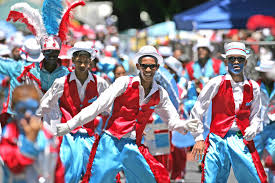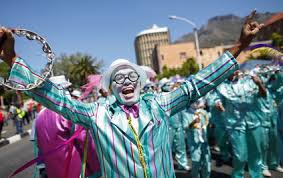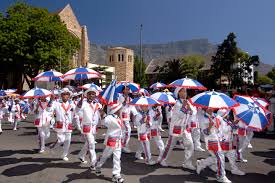When we hear the word minstrel, a white, bumbling jester in black face is what usually comes to mind. But here in the southern hemisphere, even this concept is upside down. Be it irony, or just oddity, The Cape Town Minstrel Carnival is a jovial parade of mix-raced people, known in South Africa as Cape Coloured or Cape Malay, in white-face (gulp).
Afrikaans, South Africa's former official language, is a funny old vernacular. English is now the official language of SA, but the heritage of language is a strong cultural identifier, and Afrikaans people are hard-pressed to give that up, regardless of ridiculousness. For instance, a chain of religious bookshops is called CUM Books, school is ironically spelled with a K (skool), you don't park your car, you parker it in a parkering garage, and a soda is called, oddly, a cool drink. And there is a cinema disturbingly named 'The Labia'.
The Cape Town Minstrel Carnival has many names, most of which you would not repeat in today's society unless you enjoyed screeching racism. Tweede Nuwe Jaar, which translates to Second New Year, ie: the Second of January, which was the traditional yearly day off for Cape slaves, is the official name of the parade. Another name for the parade, assumedly termed by said racists, refers to the largest, nocturnal, procyonid found in North America.
The carnival is also known as the Kaape Klopse Karnival, or by it acronym ( double-gulp) the KKK.*
The heart of the vibrant Cape Malay community was located District 6. in the 1970's the residents of District 6 were forcibly moved out of town by the Apartheid government, to the Cape Flats; and the area was completely destroyed The only things left standing were a church and a few homes. District 6 remains this way today; an empty field with a church and a few houses. It is here were the Cape Town Minstrel Carnival parade begins.
The Carnival, similar in vibrance to Mardi Gras in Brazil and New Orleans, is made of of many well-rehearsed groups of fancily dressed performers, often carrying umbrellas, who make their way from District 6, pass the local government buildings in the CBD, along Darling and Adderley streets all the way up to Bo-Kaap, the brightly-coloured historical centre of Cape Malay culture. Emphasis here on up, as the entire journey is up hill...and it's hot...and the people are dancing!!!!
The parade begins at 12pm until whenever it gets to Bo-Kaap, where the contests and parties continue through the night and through the entire month of January. Many people now arrive very early and stake out their viewing positions with large marquees, so getting a good view is not always easy. Also, many of the roads in the area are closed off to traffic, so it is best to park elsewhere and walk to the parade route.
Traditions are wonderful things, but I was happy to note that most of the face paint was decorative and not racist, and the costumes and routines where spectacular. The only problem I had was that it was so bloody hot and my parade tradition is of a cold New York City, on the last Thursday in November, as seen by the perfect view through my television set.
* the acronym KKK, when referring to the Kape Klopse Karnival is usually followed by an A, standing for Association (KKKA). Still....






Comments